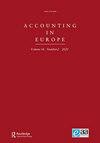The Routledge Companion to Qualitative Accounting Research Methods
IF 4.6
Q1 BUSINESS, FINANCE
引用次数: 20
Abstract
approach for valuing brands. It is based on trading and/or transaction multiples from comparable firms whose value is mostly driven by brands. Chapter eight presents a cost-based method that relies on estimating the investments necessary to reproduce a similar brand. These investments may be assessed from historical costs data or from a reproduction costs analysis. The last part of the book starts with chapter nine. It encompasses valuation standards that strive to provide common practices, and common methodologies. It provides an overview of the contexts (i.e. specifically during the 2008 financial crisis) in which the standards have emerged and the issues they raised (i.e. inconsistencies in assets valuation). The pros and cons of brand valuation within standards such as IFRS, US Generally Accepted Accounting Principles (US GAAP), International Valuation Standards Council (IVSC), ISO 10668 and International Association of Consultants Valuators and Analysts (IACVA) are discussed. Chapter ten lists and discusses the major ad hoc valuation models for brand. The models are grouped according to whether they rely on (1) the Excess Earning approach (two models from Interbrand and BrandEconomics are described and discussed), (2) the Relief-from-Royalties (with the discussion of the BrandFinance model) (3) and market multiples (with the discussion of the Brand Equity Evaluation System, BEES). Chapter eleven deals with the factors affecting brands volatility. First the quantity of available financial data on brands necessary to estimate their value is quite low. Second, two conceptual issues leads to higher uncertainty with classical valuation models, i.e. the ubiquity of brands (i.e. unlike other assets that are usually scarce resources), and the positive demand externalities (i.e. the brand is used the better it is). The chapter then introduces and discusses new areas for brand valuation, such as real options and the need to account for synergies and interactions between a brand and other intangibles (e.g. human capital). Overall, this book provides a rich overview of the main brand valuation models. It also emphasizes issues taken from relevant real cases. The analysis offers a good synthesis and a comparison among the numerous models. Furthermore, the book contains numerous references from the finance and accounting literature. The approach enables the reader to understand the reasons why brand values may differ upon evaluators. Its target audience can be then oriented toward both practitioners and graduate students which may grasp interesting input with the real-life cases.定性会计研究方法的劳特利奇同伴
评估品牌价值的方法。它是根据可比公司的交易和/或交易倍数计算的,这些公司的价值主要由品牌驱动。第八章提出了一种基于成本的方法,该方法依赖于估计再生产类似品牌所需的投资。这些投资可以根据历史成本数据或再生产成本分析进行评估。这本书的最后一部分从第九章开始。它包含了努力提供通用实践和通用方法的评估标准。它概述了标准出现的背景(即特别是在2008年金融危机期间)以及它们提出的问题(即资产估值不一致)。在国际财务报告准则(IFRS)、美国公认会计原则(US GAAP)、国际评估标准理事会(IVSC)、ISO 10668和国际顾问评估师和分析师协会(IACVA)等标准下,讨论了品牌估值的利弊。第十章列出并讨论了主要的品牌特别评估模型。这些模型根据它们是否依赖于(1)超额收益方法(描述和讨论了Interbrand和BrandEconomics的两个模型),(2)特许权使用费减免(讨论了BrandFinance模型)(3)和市场倍数(讨论了品牌资产评估系统,BEES)进行分组。第十一章分析了影响品牌波动的因素。首先,估计品牌价值所需的可用财务数据数量相当少。其次,经典估值模型的两个概念性问题导致了更高的不确定性,即品牌的普遍性(即不像其他资产通常是稀缺资源)和正需求外部性(即品牌越用越好)。本章随后介绍并讨论了品牌估值的新领域,如实物期权和考虑品牌与其他无形资产(如人力资本)之间的协同效应和相互作用的需要。总体而言,本书提供了主要品牌估值模型的丰富概述。它还强调从相关实际案例中提取的问题。该分析在众多模型之间提供了很好的综合和比较。此外,这本书包含了大量的参考资料,从金融和会计文献。这种方法使读者能够理解为什么品牌价值在评估者身上可能会有所不同。它的目标受众可以面向从业者和研究生,他们可能会通过现实生活中的案例获得有趣的输入。
本文章由计算机程序翻译,如有差异,请以英文原文为准。
求助全文
约1分钟内获得全文
求助全文

 求助内容:
求助内容: 应助结果提醒方式:
应助结果提醒方式:


